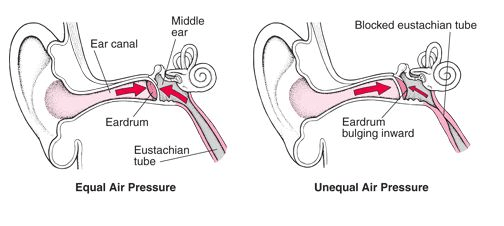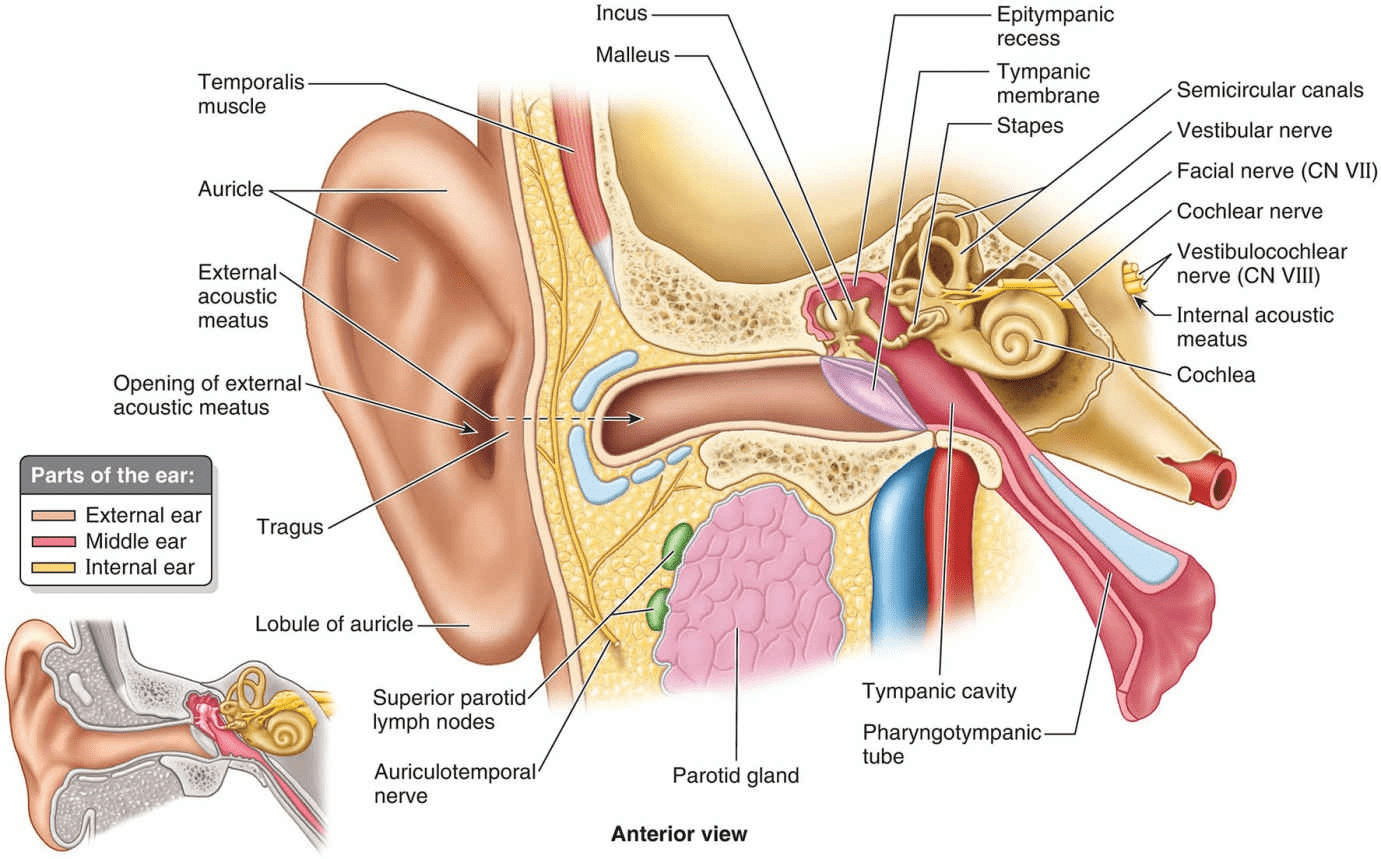Blockage of Pharyngotympanic Tube
content of this page
1- Introduction
2- Anatomical Overview
3- Causes
4- Treatment
Introduction
The blockage of the pharyngotympanic tube, also known as the Eustachian tube, is a condition that affects the middle ear’s ventilation and pressure regulation. This small canal connects the middle ear to the nasopharynx (the upper part of the throat behind the nose). Its primary function is to equalize pressure between the middle ear and the external environment, which is essential for maintaining proper hearing and balance.

Anatomical Overview
The pharyngotympanic tube forms a route for an infection to pass from the nasopharynx to the tympanic cavity. This tube is easily blocked by swelling of its mucous membrane, even as a result of mild infections (e.g., a cold), because the walls of its cartilaginous part are normally already in apposition. When the pharyngotympanic tube is occluded, residual air in the tympanic cavity is usually absorbed into the mucosal blood vessels, resulting in lower pressure in the tympanic cavity, retraction of the tympanic membrane, and interference with its free movement. Finally, hearing is affected.

Causes
Upper Respiratory Infections: Viral or bacterial infections such as colds, flu, sinusitis, or adenoiditis can lead to inflammation and swelling of the mucous membranes lining the Eustachian tube. This swelling can obstruct the tube, preventing it from opening and closing properly.
Allergic Rhinitis: Allergies affecting the nasal passages can cause nasal congestion and inflammation, which can extend to the Eustachian tube and impair its function.
Nasal Congestion: Any condition causing nasal congestion, such as allergic rhinitis, sinus infections, nasal polyps, or anatomical abnormalities (e.g., deviated septum), can physically block the opening of the Eustachian tube.
Eustachian Tube Dysfunction (ETD): This umbrella term covers various conditions where the Eustachian tube fails to open or close adequately, leading to problems with pressure equalization. Causes of ETD can include changes in air pressure (e.g., during air travel), sudden loud noises, or changes in altitude.
Middle Ear Infections (Otitis Media): Acute or chronic infections of the middle ear can cause inflammation and fluid accumulation behind the eardrum, which can obstruct the Eustachian tube and impair its function.
Barotrauma: Rapid changes in air pressure, such as during air travel, scuba diving, or driving in mountainous areas, can stress the Eustachian tube and cause temporary blockage.
Tumors or Growths: Rarely, benign or malignant tumors in the nasopharynx or nearby structures can exert pressure on or invade the Eustachian tube, leading to blockage.
Foreign Objects: Insertion of foreign objects into the nasal cavity can physically obstruct the Eustachian tube opening.
Aging: As individuals age, the Eustachian tube may become less flexible and more prone to dysfunction, contributing to blockage and symptoms of Eustachian tube dysfunction.
Smoking: Tobacco smoke and other pollutants can irritate the nasal and throat tissues, leading to inflammation and potential Eustachian tube dysfunction.
Treatment
Initial and Conservative Management:
Nasal Decongestants: Medications such as oral decongestants (pseudoephedrine) or nasal decongestant sprays (oxymetazoline) can help reduce nasal congestion and swelling, allowing the Eustachian tube to open more easily. However, nasal sprays should not be used for more than a few days to avoid rebound congestion.
Nasal Steroid Sprays: Corticosteroid nasal sprays (e.g., fluticasone, mometasone) may be prescribed to reduce inflammation in the nasal passages and Eustachian tube, improving function over time.
Autoinflation Techniques: Techniques like the Valsalva maneuver or the Toynbee maneuver can help open the Eustachian tube by equalizing pressure. These maneuvers involve techniques such as gently blowing with the nose pinched shut or swallowing with the nose pinched and mouth closed.
Chewing Gum or Yawning: Encouraging activities that promote swallowing and jaw movement can help naturally open the Eustachian tube and promote ventilation of the middle ear.
Medical Interventions:
Ear Tubes (Tympanostomy Tubes): In cases of chronic Eustachian tube dysfunction or recurrent middle ear infections, tympanostomy tubes may be inserted into the eardrum to ventilate the middle ear and equalize pressure. These tiny tubes allow air to enter the middle ear space and can help prevent fluid buildup.
Nasal Balloon Dilation: A minimally invasive procedure where a balloon catheter is inserted into the Eustachian tube through the nose and inflated to widen the tube and improve ventilation.
Myringotomy: In some cases, a small incision (myringotomy) may be made in the eardrum to drain fluid from the middle ear and relieve pressure. This may be combined with tympanostomy tube placement.
Management of Underlying Conditions:
Treating Nasal and Sinus Conditions: Addressing underlying conditions such as allergic rhinitis, sinusitis, nasal polyps, or anatomical abnormalities (e.g., deviated septum) can help reduce nasal congestion and improve Eustachian tube function.
Managing Middle Ear Infections: Prompt treatment with antibiotics for acute otitis media or other middle ear infections can help resolve inflammation and fluid buildup, which can contribute to Eustachian tube blockage.
Lifestyle and Preventive Measures:
Avoiding Tobacco Smoke and Irritants: Avoiding exposure to tobacco smoke and other air pollutants can help reduce inflammation in the nasal and throat tissues, which may improve Eustachian tube function.
Maintaining Adequate Hydration: Staying hydrated helps keep nasal secretions thin and reduces the risk of nasal congestion.
Managing Allergies: Effective management of allergies through medications or allergen avoidance can reduce nasal inflammation and congestion.
Surgical Options:
Surgical interventions are generally considered when conservative treatments fail to improve symptoms or in cases of severe or chronic Eustachian tube dysfunction. These may include:
Eustachian Tube Balloon Dilation: A procedure where a balloon catheter is used to dilate and open the Eustachian tube.
Eustachian Tube Surgery: Surgical techniques such as Eustachian tube ligation or laser-assisted procedures may be considered in rare cases of persistent dysfunction or structural abnormalities.
Consultation with an ENT Specialist:
For persistent or recurrent Eustachian tube blockage, consultation with an ear, nose, and throat (ENT) specialist is recommended. They can perform a comprehensive evaluation, determine the underlying cause, and recommend appropriate treatment options tailored to individual needs. Prompt and appropriate management can help alleviate symptoms, improve middle ear function, and prevent complications associated with Eustachian tube dysfunction.